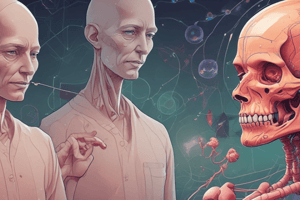Podcast
Questions and Answers
What percentage of all cancer cases reported are carcinoma?
What percentage of all cancer cases reported are carcinoma?
- 80-90% (correct)
- 90-95%
- 95-100%
- 70-80%
Which type of cancer is derived from white blood cells or their precursors?
Which type of cancer is derived from white blood cells or their precursors?
- Myelomas
- Leukemia (correct)
- Sarcoma
- Lymphoma
What is the primary cause of DNA faults leading to cancer?
What is the primary cause of DNA faults leading to cancer?
- Genetic disorders
- Environmental factors
- Viral infections
- Accumulation of faults in our DNA (correct)
What is the term for mutations that can be passed on to offspring?
What is the term for mutations that can be passed on to offspring?
What is the term for the uncontrolled proliferation of cells leading to tumor formation?
What is the term for the uncontrolled proliferation of cells leading to tumor formation?
What is the primary goal of surgery in cancer treatment?
What is the primary goal of surgery in cancer treatment?
What type of cancer is derived from bone marrow derived cells that affect the lymphatic system?
What type of cancer is derived from bone marrow derived cells that affect the lymphatic system?
What is the term for the process by which genetic mutations lead to cancer?
What is the term for the process by which genetic mutations lead to cancer?
What is the type of chemical bonding involved in the mechanism of action of chlormethine?
What is the type of chemical bonding involved in the mechanism of action of chlormethine?
What is the consequence of DNA unable to replicate and synthesize proteins and other essential cell metabolites?
What is the consequence of DNA unable to replicate and synthesize proteins and other essential cell metabolites?
What is the main use of chlormethine in medicine?
What is the main use of chlormethine in medicine?
What is generated during the mechanism of action of chlormethine that acts as an alkylating agent?
What is generated during the mechanism of action of chlormethine that acts as an alkylating agent?
What is the purpose of using 0.16 M sodium thiosulfate and ice packs during the administration of chlormethine?
What is the purpose of using 0.16 M sodium thiosulfate and ice packs during the administration of chlormethine?
What is the result of intrastrand and interstrand cross-linking caused by chlormethine?
What is the result of intrastrand and interstrand cross-linking caused by chlormethine?
What is the main advantage of Chlorambucil and Melphalan in terms of bioavailability?
What is the main advantage of Chlorambucil and Melphalan in terms of bioavailability?
What is the mechanism by which Nitrogen mustards improve their uptake by cells?
What is the mechanism by which Nitrogen mustards improve their uptake by cells?
What is the fate of the aziridinium ion once it is formed?
What is the fate of the aziridinium ion once it is formed?
Why are Sulphur analogs less stable than Nitrogen analogs?
Why are Sulphur analogs less stable than Nitrogen analogs?
What is the effect of delocalization of the lone pair on the nucleophilicity of Nitrogen?
What is the effect of delocalization of the lone pair on the nucleophilicity of Nitrogen?
What is the reactivity of the aziridinium ion with HCl?
What is the reactivity of the aziridinium ion with HCl?
Why are Nitrogen mustards used as anticancer agents?
Why are Nitrogen mustards used as anticancer agents?
What is the general structure of Mechlorethamine, Chlorambucil, and Melphalan?
What is the general structure of Mechlorethamine, Chlorambucil, and Melphalan?
What is the primary function of Mechlorethamine as an alkylating agent?
What is the primary function of Mechlorethamine as an alkylating agent?
What is the predicted effect of substituting an aromatic ring for a methyl group in nitrogen mustards?
What is the predicted effect of substituting an aromatic ring for a methyl group in nitrogen mustards?
What is the consequence of Mechlorethamine's high reactivity as an alkylating agent?
What is the consequence of Mechlorethamine's high reactivity as an alkylating agent?
What is the functional group responsible for the alkylating activity of Mechlorethamine?
What is the functional group responsible for the alkylating activity of Mechlorethamine?
What is the expected outcome of crosslinking DNA strands through alkylation?
What is the expected outcome of crosslinking DNA strands through alkylation?
What is the purpose of using nitrogen mustards as anti-cancer agents?
What is the purpose of using nitrogen mustards as anti-cancer agents?
What is the consequence of Mechlorethamine's ability to form covalent bonds with DNA?
What is the consequence of Mechlorethamine's ability to form covalent bonds with DNA?
What is the effect of Mechlorethamine on the structure of DNA?
What is the effect of Mechlorethamine on the structure of DNA?
What is the mechanism by which Mechlorethamine interacts with DNA?
What is the mechanism by which Mechlorethamine interacts with DNA?
What is the rationale behind substituting an aromatic ring for a methyl group in nitrogen mustards?
What is the rationale behind substituting an aromatic ring for a methyl group in nitrogen mustards?
What is the purpose of 4-phenylbutyric acid in the synthesis of chlorambucil?
What is the purpose of 4-phenylbutyric acid in the synthesis of chlorambucil?
What is the effect of the aromatic ring in chlorambucil on its reactivity?
What is the effect of the aromatic ring in chlorambucil on its reactivity?
What is the advantage of melphalan compared to other alkylating agents?
What is the advantage of melphalan compared to other alkylating agents?
What is the mechanism of action of uracil mustard?
What is the mechanism of action of uracil mustard?
What is the purpose of estramustine?
What is the purpose of estramustine?
What is the activation mechanism of cyclophosphamide?
What is the activation mechanism of cyclophosphamide?
What is the toxic metabolite responsible for hemorrhagic cystitis in cyclophosphamide treatment?
What is the toxic metabolite responsible for hemorrhagic cystitis in cyclophosphamide treatment?
What is the indication for using cyclophosphamide?
What is the indication for using cyclophosphamide?
What is the effect of the urethane group in urethane on its reactivity?
What is the effect of the urethane group in urethane on its reactivity?
What is the common feature of melphalan and uracil mustard?
What is the common feature of melphalan and uracil mustard?
Flashcards are hidden until you start studying
Study Notes
Cancer Types
- Cancer types are categorized based on the functions/locations of the cells from which they originate
- Carcinoma: a tumor derived from epithelial cells (80-90% of all cancer cases reported)
- Sarcoma: a tumor derived from muscle, bone, cartilage, fat or connective tissues
- Leukemia: a cancer derived from white blood cells or their precursors
- Lymphoma: a cancer of bone marrow derived cells that affects the lymphatic system
- Myelomas: a cancer involving the white blood cells responsible for the production of antibodies (B lymphocytes)
Causes of Cancer
- Accumulation of faults in our DNA causes cells to divide out of control
- DNA faults can be caused by inborn mutations of cancer susceptibility genes or acquired mutations
Biochemical Basis of Cancer: Mutation
- Genetic mutations within a single affected cell lead to monoclonal development
- Genes affected can be those controlling cell cycle, DNA repair and/or differentiation
- This leads to uncontrolled proliferation and tumor formation
- Mutations can be germline (inherited) or somatic (not inherited)
Cancer Treatment
- Four primary modalities are employed in the approach to cancer treatment: surgery, radiation, chemotherapy, and other therapies
- Surgery offers the greatest chance for cure, especially if the cancer has not spread to other parts of the body
- Radiation therapy uses high-energy particles or waves to destroy or damage cancer cells
- Alkylating agents are a type of chemotherapy that causes intrastrand and interstrand cross-linking, preventing DNA replication and leading to cell death
Alkylating Agents
- Chlormethine (Mechlorethamine) is an alkylating agent used to treat Hodgkin's disease and non-Hodgkin's lymphoma
- Mechanism of Action: Generation of highly reactive “aziridinium ions” that act as alkylating agents to cross-link DNA producing defective DNA and abnormal cellular function and eventually cell death
- Analogs of Chlormethine with better properties have been prepared
- Rationales used to improve nitrogen mustards include substituting an aromatic ring for a methyl group, which increases chemical stability and decreases the rate of alkylation
- Attachment of amino acid, nucleic acid base or hormone to nitrogen mustards improves their uptake by using the carrier protein
Synthesis of Chlorambucil
- Chlorambucil is synthesized through nitration, followed by phosphorylation and hydrolysis
Alkylating Agents: Chlorambucil
- Chlorambucil has an aromatic ring, which is electron-withdrawing and lowers the nucleophilic strength of nitrogen, making it a less reactive alkylating agent
- Chlorambucil is less toxic and has fewer side reactions due to the aromatic ring
Alkylating Agents: Melphalan
- Melphalan has an aromatic ring and mimics phenylalanine, allowing it to be transported into cells by transport proteins
- Melphalan is less reactive alkylating agent due to the aromatic ring
Alkylating Agents: Uracil Mustard
- Uracil mustard has an electron-withdrawing uracil ring, making it a less reactive alkylating agent
- Uracil mustard mimics a nucleic acid base and is concentrated in fast-growing cells
Alkylating Agents: Estramustine
- Estramustine has an alkylating group attached to oestradiol, allowing it to cross cell membranes due to its hydrophobicity
- Estramustine is used to treat prostate cancer
Cyclophosphamide
- Cyclophosphamide is the most commonly used alkylating agent
- It is a non-toxic prodrug that requires CYP450 for activation
- Acrolein is a toxic metabolite responsible for hemorragic cystitis
- Cyclophosphamide is used to treat malignant lymphomas, mycosis fungoides, and leukemias, as well as severe rheumatoid arthritis and systemic lupus erythematosus.
Studying That Suits You
Use AI to generate personalized quizzes and flashcards to suit your learning preferences.




